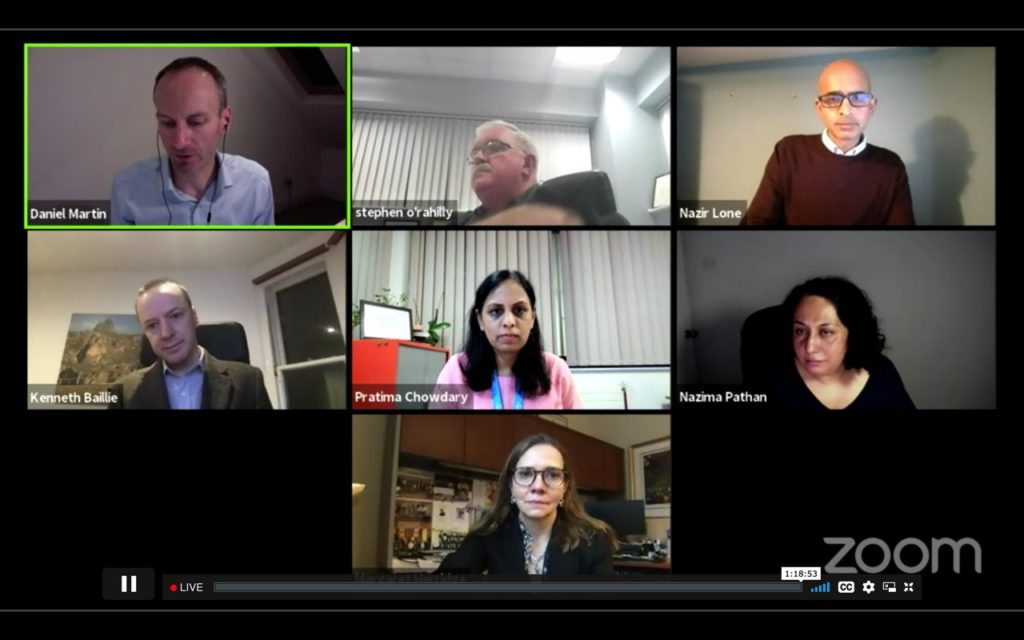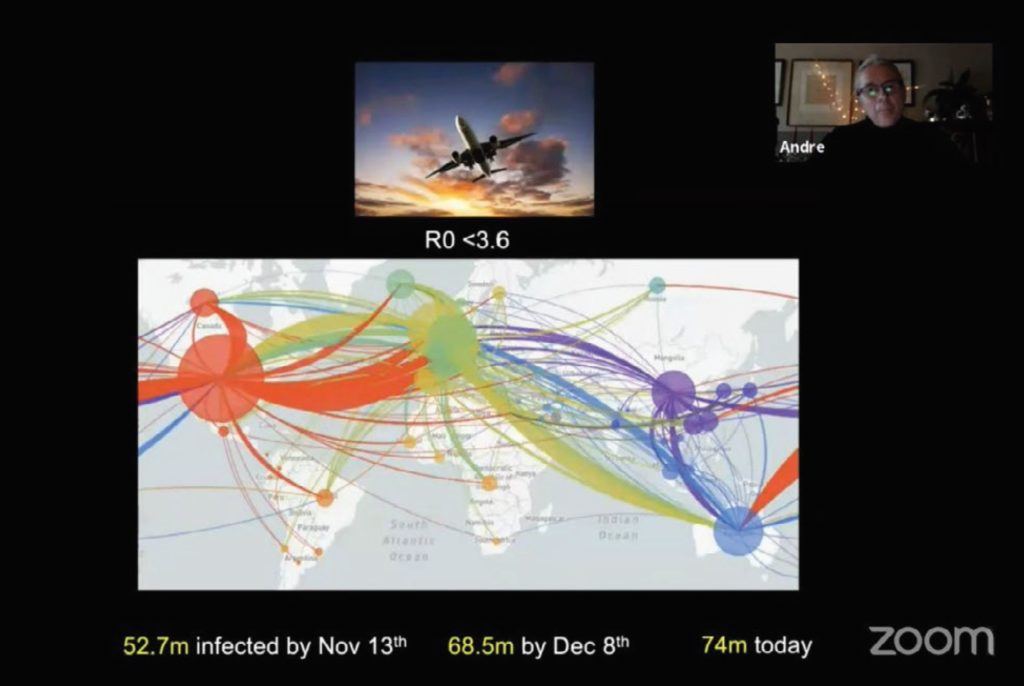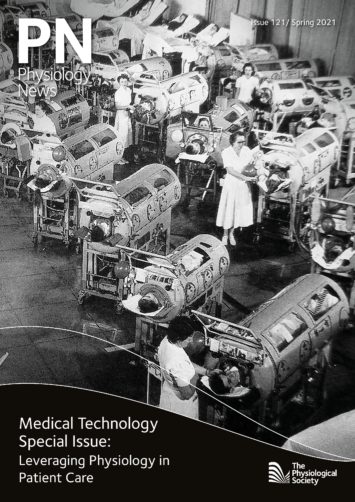
Physiology News Magazine
COVID-19 Conference: Lessons Learned from the Frontline
Events
COVID-19 Conference: Lessons Learned from the Frontline
Events
Jacqueline Bennion, Therapy Services, Royal Free London, NHS Foundation Trust, UK
https://doi.org/10.36866/pn.121.34
In December 2020, The Physiological Society and the Intensive Care Society came together to host an exciting 3-day virtual conference focusing on the challenges of understanding the pathophysiological changes occurring throughout the body following COVID-19 infection. The conference shared current knowledge and thinking across many physiological systems, showcased the symbiotic relationship between physiology and critical care, and helped set the agenda for research to identify future treatments and therapies.
This conference, organised by Susan Deuchars, University of Leeds, UK, Steve Mathieu, Queen Alexandra Hospital, Portsmouth, UK, Mike Tipton, University of Portsmouth, UK and Hugh Montgomery, University College London, UK, was held just 1 year on from the early cases reported in Wuhan. It was unique in enabling the voices from physiology and intensive care to come together to discuss the challenges of identifying future therapies, the importance of rehabilitation and what questions remained unanswered. Both learned societies were delighted to bring together experts across disciplines to reflect on how we can progress our understanding of COVID-19, to improve outcomes in the future.
In 1952 a consultant anaesthetist Dr Bjorn Ibsen described what was the beginning of critical care medicine and the invention of manual positive-pressure ventilation during the polio epidemic in Copenhagen (Ibsen, 1954). And so, critical care was born, through a marriage of innovation between physiologists and clinical medicine during a tragic time in history.
The epidemic had resulted in daily local conferences to discuss lessons learnt. The effort developed collaborations between local anaesthetics, cardiologists, physiologists, nurses, physiotherapists, and ear, nose and throat surgeons. As a result, the diversity of critical care that makes it challenging to define was established.
Despite its youth, critical care has since produced innovation and multidisciplinary teams to improve the care of the most vulnerable and critically ill in society. Moreover it has built collaborative networks such as the International Forum for Acute Care Trialists to tackle equality in health education across global critical care units (InFACT). Over the course of just a few decades, it has evolved its focus from measuring patient survival to acknowledging the need for generalisable preventive and therapeutic interventions, in order to address the global burden of critical illness (Adhikari, Fowler et al., 2010).
The COVID-19 pandemic has been, and still is, a painful and terribly sad time that will undoubtedly mark history. However, just as at the birth of critical care, there have been golden discoveries. From 14 – 16 December 2020, The Physiological Society, in collaboration with the Intensive Care Society, held a virtual conference featuring a sincere panel of experts. The panel represented a variety of areas of expertise such as genetics, virology, intensive care medicine, and exercise physiology.

The introduction of the conference reflected upon the challenges of COVID-19. Intensive care consultant, Andre Vercueil, described the role of social media, and specifically WhatsApp, in drawing together anecdotal evidence between clinicians, physiologists and researchers to enable them to prepare, problem solve and learn. For example, he described how a professor from Italy WhatsApped a list of information about how to “get ready” for the COVID-19 virus, prior to its devastating arrival in the UK.
The conference eloquently communicated experiences, reflections, evidence, expertise and questions relating to the main human systems from micro to macro levels of physiology. The application of these equipped the critical care community to provide safe practice for critically ill patients, their families and relatives. The motivation of the conference, to ask questions and learn as a collaborative community, was demonstrated throughout, with open dialogue between novice and expert attendees, as well as with the expert panel.
Lessons I learnt included the role of clinical protocols, and the importance of a grounded physiological understanding in our response as clinicians. For example, intensivists and physiologists discussed the initial and current management of positive end expiratory pressures (PEEP) of mechanically-ventilated COVID-19 patients. This brought with it a discussion around the potential presence of physiologists in critical care.
Additional learning points included the increased number of physiotherapists carrying out rehabilitation in critical care and their role in patients’ recovery from critical illness. We also discussed the complex role of science in governmental decision-making between public health and socioeconomic implications. Moreover, we reflected upon the observed grievous trends in the COVID-19 data suggesting social inequalities still very much exist in our UK society. To complete the conference, conversations centred on how conferences can host such an eclectic collaboration in the future to tackle current health issues. An expert panellist commented they had, “enjoyed making extensive notes and gathered more ideas from the collaborative discussions throughout this Physiological Society conference than they had for some time”.
On reflection as a novice clinician and clinical researcher, the COVID-19 conference showcased the growth and development in innovation and care for the most vulnerable in society that has happened since the epidemic critical care was born. It demonstrated the unique and significant role of eclectic collaboration and confirmed that we all have a part to play, contributions to make, questions to ask, and so much to learn. Furthermore, the conference was a testament to the role of social media in developing knowledge sharing, diverse collaboration and innovation from a local position to what is now a shared global critical care community.

References
Adhikari KJ et al. (2010). Critical care and the global burden of critical illness in adults. The Lancet 376. https://doi.org/10.1016/S0140- 6736(10)60446-1.
Ibsen B (1954), The Anæsthetist’s Viewpoint on the Treatment of Respiratory Complications in Poliomyelitis during the Epidemic in Copenhagen, 1952. Journal of the Royal Society of Medicine 47(1), 72–74.
InFACT International Forum for Acute Care Trialists. Promoting International Collaboration. Available: https:// www.infactglobal.org/our-vision.
